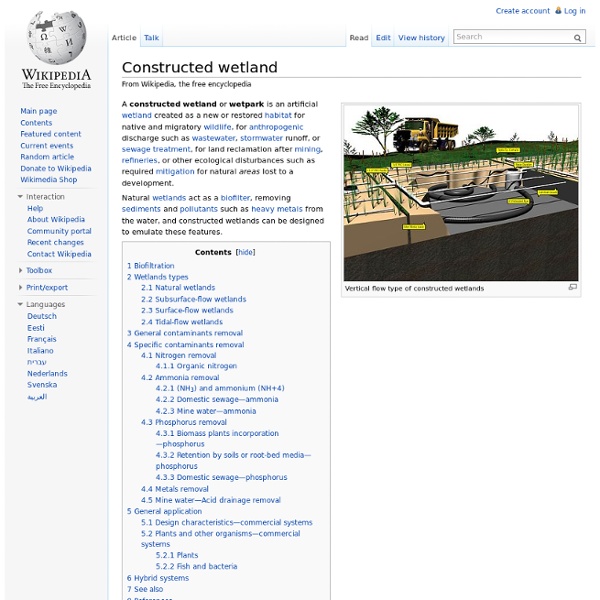Constructed wetland

A20 - Macrophyte filters
NB. This fact sheet supplements fact sheet A17 "Various ecological effluent treatment solutions" 1) What is involved ? Constructed wetlands are involved in several effluent treatment systems presented in fact sheet A17.They contribute to removing organic matter and impurities from wastewater.They are sometimes called "constructed wetlands". Their principle involves causing water to flow through a gravel filter on which macrophyte plants (aquatic plants), such as reeds are grown. There are two types of filters : horizontal and vertical. 2) Vertical constructed wetlands Principle Vertical filters are not fed continuously, but by intermittent scoops (see fact sheet A18 "Systems for spreading wastewater by tanks"). Feeding and discharge Source : Macrophyte plant group and Water treatment The scoop system must be designed so that each scoop covers the filter with a layer of 2 to 5 cm of water. Here are several ways of spreading water on the filter : The main filter element : the filter bed 5) Cost
BioHaven Floating Islands from Patriot Land & Wildlife Management
Patriot Land and Wildlife, in conjunction with Bluewing Environmental Solutions, is the Maryland sales representative as well as the official certified installer for the revolutionary BioHaven Floating Island systems in Maryland and Virginia. BioHaven® floating islands (also known as floating treatment wetlands or FTWs) are a new and powerful tool in water stewardship. They biomimic natural floating islands to create a “concentrated” wetland effect. Independent laboratory tests showed removal rates far in excess of previously published data: 20 times more nitrate, 10 times more phosphate and 11 times more ammonia, using unplanted islands. With the correct plant selection, wildlife habitat can be effectively created, giving food, shelter, and protection to waterfowl and other animals. waterscape.
DIY Reed bed
The reed bed is really just a pond filled with gravel of different sizes with reeds growing on the surface. We built our DIY reed bed from the broken concrete we had from our work on the property, bedded together with mud and with turfs on the outer walls. Our reed bed is raised above ground to give enable to outflow to enter the pond at the right level. The bed is lined with carpet and pond liner and filled with layers of gravel and pea gravel with a thin layer of sand at the surface. Reed beds are categorised as horizontal beds where the water enters at one end and flows horizontally to the outlet collector and vertical beds where the water flows down vertically through the bed. Our reed bed is only dealing with bath and washing water (not sewage) and is about 4 square metres in area and 35cms deep PDF on reed bed construction Water harvesting PDF
Related:
Related:



